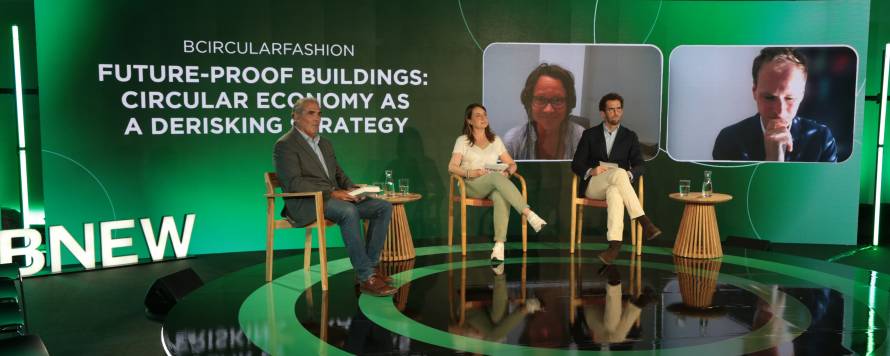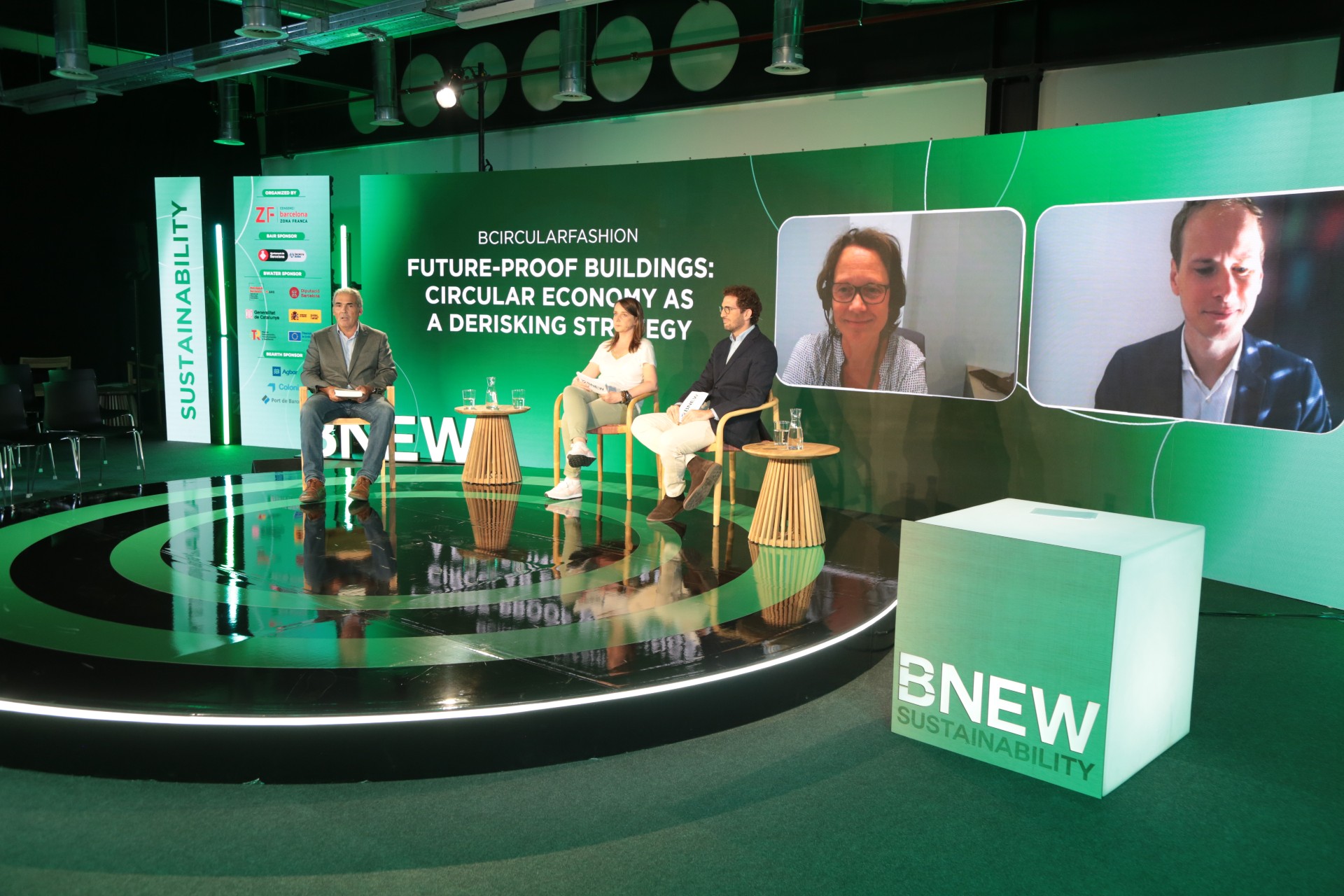
21 October 2022
Future-proof buildings: circular economy as a derisking strategy
EIG participated in Barcelona New Economy Week (BNEW) in a round table where leading figures from the European scene explored the potential of circular economy in real estate sector
We recently had the pleasure of participating in Barcelona New Economy Week (BNEW), the annual event organised by the Consorci de la Zona Franca. Located at the DFactory, this year’s event opted for face-to-face attendance, while also maintaining the streaming format. In this edition, we had the honour of chairing a session, where we invited leading figures from the European scene to explore the potential of the circular economy as a derisking strategy for the real estate sector.
Ignasi Cubiña, EIG’s President and CIO of Grupo Construcía, that has been moderating the round table, started saying “We have talked a lot about Circular Economy in the last 10 years. Now it is time for action. Accompanied by Josefina Lindblom (Policy Officer, European Commission), Cécile Imbert (CEO, Fern Paris), Thomas Van Oppens (Deputy mayor for material management, City of Leuven) and Cástor González (CEO, Circular Capital), Cubiñá centred the conversation on the possibility of accelerating positive change through the implementation of the circular economy in building, and its repercussions for the real estate sector.
The dialogue focused on 5 questions, starting with the basics: If Built Environment is part of the problem, do you think Circular Built Environment is part of the solution or the whole solution?
Setting the scene of the impacts of the Built Environment, Cécile Imbert pointed out: “In terms of CO2 emission, we all know that the market has already fixed what we call the operational emission due to electricity consumption, heating and cooling”. The tipping point is to fix the embodied carbon (the emission generated during the whole lifecycle of a building and its materials, from manufacturing, transport, construction, use and end of life). “The circular economy addresses this point through its ability to assess and evaluate the CO2 emissions and actually reduce them”.
The resource scarcity was the other issue that came out, leading to inflation on raw materials. Cécile Imbert commented that recycling is an incomplete solution because it does not fix the problem of raw materials depletion and the corresponding CO2 emissions. Through a circular economy implementation project in France, for example, Fern that is specialized in circular design solutions for real estate and construction sectors, and EIG tackled this problem by introducing reused materials or upcycling material to keep them in use as long as possible.
Thomas Van Oppens who deals with reality at the local level, also agreed that circular economy is part of the solution of the problems of the built environment. The context of the perfect storm (climate change, lack of new materials and people willing to look for sustainable alternatives) is the perfect opportunity for a new economy to rise out from these problems and offer some solutions. For example, in Leuven, the government has created a bank for used building materials, and after two years, they have already achieved the break even point, so it has become a sustainable business model. Indeed, people agree that the doors of their house are not all the same, and they are also ready to pay for things that are already used. Some even say there is a kind of charm to it.
Josefina Lindblom brough also sufficiency to the conversation. How many sqm are really needed for buildings, how can we use them more efficiently. Under this light, the focus should be in refurbish and renovation rather than demolishing and building new.
Circularity is about extending the lifetime of the building and its materials, it is also about having flexible and adaptable buildings so that we can use them for different needs, and it is about designing our buildings for assembly and disassembly.
Level(s) and the EU Taxonomy
Renovation is now a trend when looking at the EU funds. Ignasi wanted to explore on the link between Level(s) ambitions and the EU Taxonomy framework, as well as the Technical Screening Criteria (TSC) development status.
Josefina Lindblom who has among other things managed the recent collaborative developments of Level(s), a common framework for the assessment and reporting of the environmental performance of buildings, explained that EU Taxonomy is a way for the EU Commission to define whether an investment is sustainable or not. As they are developing the taxonomy for different kinds of sectors in steps, the first piece of legislation sets out the different criteria for different products, including buildings, in terms of their relationship to climate change. In fact, Level(s) lifetime carbon indicators were included as TSC. The next piece of legislation that looks at circularity, will include more Level(s) indicators because Level(s) is very much focused on circularity. “So there is a direct link between the EU Taxonomy and Level(s)”, remarked Josefina Lindblom.
In the words of Cécile Imbert, by her experience on the renovation projects together with EIG applying the Lean2Cladle methodology and the Level(s) framework for a French insurance company, “Level(s) ensures proper execution and it is a very helpful tool in terms of project management because everybody has the same level of information and you are sure that you are following this framework. I just regret that it’s only a volunteer approach, and not a mandatory tool, because it’s the only way that the sector is really focused on the good practice.”
Key figures of the French renovation project :
- 72% of global circularity
- 29 T of recovered resources, 66% of recovery rate
- 16 T of CO2 emissions avoided thanks to the selective diagnose
- – 46% of CO2 emissions thanks to circular materials
About the Circular Economy and its power to transform the industry
Cástor González also agreed that the Circular Economy is the right approach and that there is no alternative. From a financial perspective, he said, we have to do both: adapt the way we do business now, and create new circular business models which for example change terminal value to captured or retained value.
And what about the global decarbonization agenda?
Going to the global picture, Ignasi Cubiña pointed out that in order to achieve the decarbonization goals it is required a deep change in the industry from raw materials to recirculation (from A to D) as per the approach of the Level(s) framework. Is the market ready for that? How to manage this along the supply chain?
Thomas Van Oppens shared his experience at Leuven where stakeholders really want to manage a more sustainable supply chain but they don’t know how to start. He explained that as a local government, they started to put down rules, like asking stakeholders to make an inventory of materials, to collect information on the number of reused elements, for example. “To set the rules we need a framework, and that’s why Levels is so important.”

As he remarked, this system needs to be supported by an economy, trying to match supply with demand, which means we need suppliers for reusable materials. “That’s a role the city can play, in our opinion, where we try to make this matching platform happen with the idea that eventually now it’s an opportunity for them to participate, but in the future it will be an obligation.”
Josefina Lindblom insisted on the relevance of Level(s) as it provides a clear methodology and sets out some kind of a step-by-step approach. “There is this first level in Level(s) where you look at the different kinds of indicators in a qualitative way, and that level is more there to guide the conversation in the beginning of a project regarding what are the objectives.” “Then later on go on to work with indicators in a quantitative way.” Under this light, Level(s) act as a collaborative framework, as she added: “what many people say who use Level(s) is that it is a great tool to understand how different actors need to work together.”
Circularity and digitalization in the city: how to leave no one behind?
Currently we are facing some problems with digitalization, that turns to be a barrier for the elder population. Circular economy may rise new walls to stakeholders, how to avoid it? Thomas Van Oppens explained their experience at Leuven where, by maximizing materials reuse, they actually lowered the price of materials, widening the access to sustainable living.” And here digitalization is the enabler by matching outputs (developers needs) and inputs (market availability of reusable material).
Key takeaways
As the session got to the end, Ignasi Cubiña gave a quick wrap up summarizing on three main ideas:
“First of all, I think circular economy in the build environment is not a hype, it’s a must to have and it’s a reality already. The second thing is that this is something that needs effort, needs new tools, needs new approaches, and it needs everybody’s participation. And the third thing is that when we talk about environmental impact or social impact, especially when we talk about things like climate change and how to address climate change, I think that decarbonisation and circular economy are two sides of the same coin. I mean we need a circular economy model to make climate change mitigation and decarbonization happen not only within the European region but beyond.”